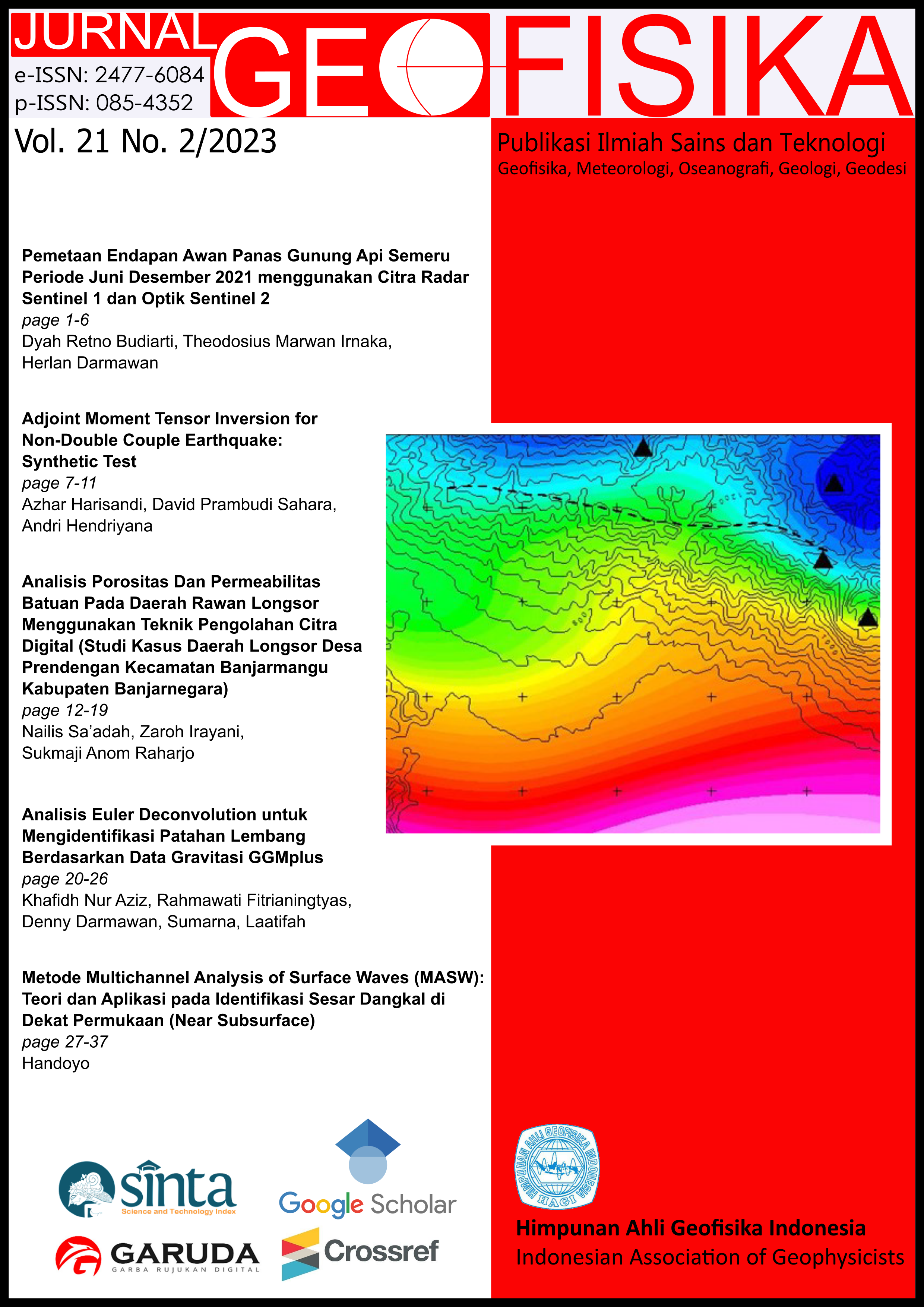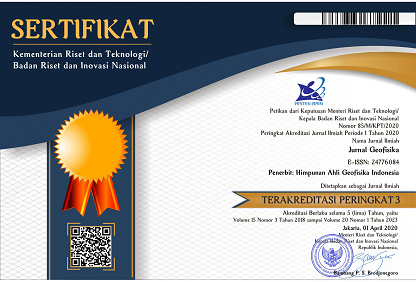Metode Multichannel Analysis of Surface Waves (MASW): Teori dan Aplikasi pada Identifikasi Sesar Dangkal di Dekat Permukaan (Near Subsurface)
Keywords
gelombang permukaan, kurva dispersi, MASW, VsAbstract
Karakterisasi fitur-fitur geologi di dekat permukaan seperti distribusi ketebalan lapisan sedimen dan struktur geologi di dekat permukaan merupakan sesuatu yang menarik dan terus dipelajari untuk memahami kondisi secara lengkap di bawah permukaan. Meteode geofisika yang dapat digunakan karena keunggulannya untuk mengkarakterisasi target-target dangkal salah satunya adalah metode Multichannel Analysis of Surface Waves (MASW). Metode MASW adalah metode yang memanfaatkan sifat dispersif dari gelombang permukaan (surface waves) untuk memodelkan distribusi kecepatan gelombang geser pada setiap lapisan secara vertikal (Vs depth model). Metode MASW terdiri dari tiga tahap yaitu akuisisi, pengolahan data (processing), dan inversi. Pada paper ini, kami mendeskripsikan konsep/teori MASW secara umum dan aplikasinya untuk karakterisasi zona sesar dangkal pada target kedalaman sekitar 150 m. Penelitian ini didukung oleh data galian (trenches study) sebagai marker terhadap bidang sesar di daerah penelitian. berdasarkan studi daan hasil yang diperoleh dari paper ini, diharapkan aplikasi metode MASW di Indonesia akan semakin berkembang dan dapat digunakan dengan kepentingan yang semakin luas.
References
Bolt, B. B. (1976). Nuclear Explosions and Earthquakes: The Parted Veil. San Francisco, CA: W.H. Freeman and Company.
Castagna, J. P., 1995, Intersecting faults, sealing faults, and other exploration issues: The Leading Edge, 14, 1187–1188.
Catchings, R.D., Hernandez, J., Goldman, M.R., Chan, J.H., Sickler, R.R., Olson, B., and Criley, C.J., 2020, 2018 U.S. Geological Survey–California Geological Survey fault-imaging surveys across the Hollywood and Santa Monica Faults, Los Angeles County, California: U.S. Geological Survey Open-File Report 2020–1049, 42 p., https://doi.org/10.3133/ofr20201049.
Constable, S.C., Parker, R.L., and Constable, G.G. (1987). "Occam's Inversion: A Practical Algorithm for Generating Smooth Models from Electromagnetic Sounding Data." Geophysics, 52, 289-300.
Demanet, D., F. Renardy, K. Vanneste, D. Jongmans, T. Camelbeeck, and M. Meghraoiu, 2001, The use of geophysical prospecting for imaging active faults in the Roer Graben, Belgium: Geophysics, 66, 78–89.
Duffy, B.; Campbell, J.; Finnemore, M.; Gomez, C. 2014. Defining fault avoidance zones and associated geotechnical properties usingMASW: A case study on the Springfield Fault, New Zealand. Eng. Geol., 183, 216–229.
Evrett, M. E. (2013). Near-Surface Applied Geophysics. Cambridge: Cambridge University Press.
Foti, S., C. G. Lay, G. J. Rix and C. Strobbia (2015). Surface Wave Methods for Near-Surface Site Characterization, CRC Press, Taylor & Francis Group.
Foti, S., Hollender, F., Garofalo, F. et al. 2018. Guidelines for the good practice of surface wave analysis: a product of the InterPACIFIC project. Bull Earthquake Eng 16, 2367–2420. https://doi.org/10.1007/s10518-017-0206-7.
Gedge, M. & Hill, M. (2012). Acoustofluidics 17: Theory and applications of surface acoustic wave devices for particle manipulation. Lab Chip, 12 (17), 2998-3007.
Gerstoft, P., Sabra, K. G., Roux, P., Kuperman, W. A., & Fehler, M. C. (2006). Green’s functions extraction and surface-wave tomography from microseisms in southern California. Geophysics, 71(4), SI23-SI31.
Haney, M.M., Qu, L., 2010. Rayleigh wave dispersion curve inversion: Occam versus L1 Norm. Society of Exploration Geophysicists, Denver SEG Annual Meeting, Expanded Abstracts, 1871-1876. DOI: 10.1190/1.3513206.
Haskell, N. A. (1953). The dispersion of surface waves on multilayered media. Bulletin of the Seismological Society of America, 43, 17–34.
Ivanov, J., Miller, R. D., Lacombe, P, Johnson, C. D., Lane, J. W. Jr. (2006): Delineating a shallow fault zone and dipping bedrock strata using multichannel analysis of surface waves with a land streamer. Geophysics. Vol. 71, No. 5 p. 39-42.
Kausel, E. & Roësset, J. M. (1981). Stiffness matrices for layered soils. Bulletin of the Seismological Society of America, 71 (6), 1743-1761.
Key, K., 2009. 1D inversion of multicomponent, multifrequency marine CSEM data: Methodology and synthetic studies for resolving thin resistive layers. Geophysics, 74(2), F9–F20. DOI: http://dx.doi.org/10.1190/1.3058434. Code at: http://marineemlab. ucsd.edu/Projects/Occam/1DCSEM.
Knopoff, L., 1972, Observation and Inversion of Surface wave dispersion, Tectonophysics, 13,497-519
McMechan, G. & Yedlin, M. J. (1981). Analysis of dispersive waves by wave field transformation. Geophysics, 46 (6), 869-874.
Miller, R. D.; Park, C. B.; Xia, J.; Ivanov, J. M. y Laflen, D. R. 2000: Potential of MASW to delineate fractures in the Winterset Limestone at the Johnson County Landfill, Kansas. Kansas Geological Survey. 27 p.
Odum, J.K., Williams, R.A., Stephenson, W.J., Worley, D.M., von Hillebrandt-Andrade, C., Asencio, E., Cameron, A., 2007. Near-surface shear wave velocity versus depth profiles, Vs 30, and NEHRP classifications for 27 sites in Puerto Rico. U.S. Geological Survey, iv, 43pp.
Ólafsdóttir, Á. E. (2014). Multichannel Analysis of Surface Waves: Methods for dispersion analysis of surface wave data. University of Iceland: School of Engineering and Natural Sciences, 76 pp.
Park, C. B., Miller, R. D. & Xia, J. (1998). Imaging dispersion curves of surface waves on multichannel record. 68th Annual International Meeting Society of Exploration Geophysicists, Expanded Abstracts, 1377-1380.
Park C.B., Miller R.D. and Xia J. 1999. Multichannel analysis of surface waves. Geophysics 64, 800–808.
Park, C. B., Miller, R. D., Xia, J. & Ivanov, J. (2007). Multichannel analysis of surface waves (MASW) - active and passive methods. The Leading Edge, 26 (1), 60-64.
Park, C. B. and Carnevale, M. (2010). Optimum MASW Survey - Revisit after a Decade of Use. In Fratta, D. O., Puppala, A. J. & Muhunthan, B (editors), GeoFlorida 2010: Advences in Analysis, Modeling and Design (pp. 1303-1312). doi: 10.1061/41095(365)130
Parker, R.L., 1994. Geophysical Inverse Theory. Princeton University Press, Princeton, NJ.
Press, W. H., Teukosky, S. A., Vetterling, W. T., and Flannery, B. P., 1992, Numerical recipes in C: Cambridge Univ. Press.
Romberg, F., 1952, Limitations of the seismic method of mapping faults: Geophysics, 17, 827–842.
Ryden, N. & Park, C. B. (2006) Fast Simulated Annealing Inversion of Surface Waves on Pavements using Phase Velocity Spectra. Geophysics, 71 (4), R49-R58.
Schwab, F. A. & Knopoff, L. (1970). Surface-wave dispersion computations. Bulletin of the Seismological Society of America, 60, 321-344.
Schilling, R. J. & Harris, S. L. (2012). Introduction to Digital Signal Processing using MATLAB. (International Edition. 2nd edition). Cengage Learning.
Socco, L.V., Foti, S., and Boiero, D. (2010). “Surface-wave analysis for building near-surface velocity models – Established approaches and new perspectives.” Geophysics, 75(5), 75A83-75A102.
Tarantola, A., and B. Valette, 1982, Generalized Nonlinear inverse problems solved using the Least Squares Criterion: Reviews of Geophysics and Space Physics, 20, no. 2, 219–232, doi:10.1029/RG020i002p00219.
Xia, J., R. D. Miller, and C. B. Park, (1999): Estimation of near-surface shear-wave velocity by inversion of Rayleigh waves. Geophysics, 64, 691–700. http://dx.doi.org/10.1190/1.1444578.
Xia, J., Miller, R. D., Park, C. B., Hunter, J. A., Harris, J. B. & Ivanov, J. (2002). Comparing shear-wave velocity profiles from multichannel analysis of surface wave with borehole measurements. Soil Dynamics and Earthquake Engineering, 22 (3), 181-190.
2011 Lorca earthquake, diakses pada 2 Februari 2023 dari wikipedia.org/wiki/2011_Lorca_earthquake

This work is licensed under a Creative Commons Attribution 4.0 International License.
The copyright of all articles belongs to the authors. All other copyrights is held by the Journal











